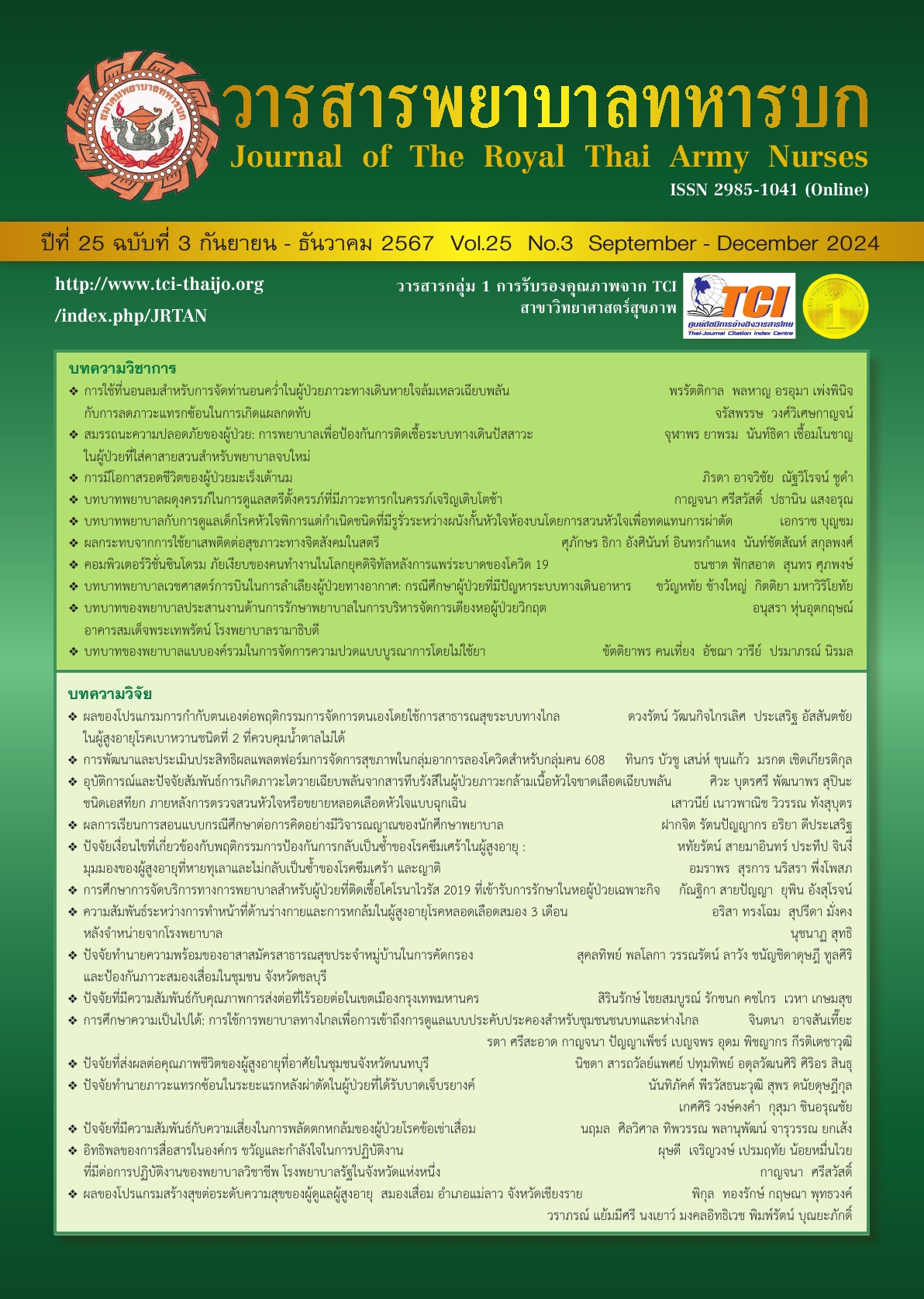A Feasibility Study: Using Tele Nursing to Improve Palliative Care Access for Rural and Remote Communities
Keywords:
TeleNursing, Palliative care, Rural and Remote, Communities, Feasibility studyAbstract
This research was a qualitative study aimed at assessing the feasibility of tele-nursing in providing palliative care access for rural and remote communities. It also aimed to explore the issues, barriers, and solutions in implementing tele-nursing. The sample group, selected through purposive sampling, included nurses, village health volunteers (VHVs), community health caregivers,patients,and families receiving palliative care,totaling 26 people. The group was divided into two sessions, each with 13 participants. Data collection tools included in-depth interviews and group discussions, with data analyzed through content analysis.
The results indicated that tele-nursing is feasible in rural and remote communities. The feasibility of tele-nursing for accessing palliative care in these communities were as follows: 1) availability of technological infrastructure, 2) healthcare facility infrastructure, 3) data backup systems, 4) operational regulations, 5) community resources and cooperation, 6) data security, and 7) affordable costs. Additionally, supporting factors included 1) a seamless community care system, 2) community goodwill resources, 3) a passion for service and responsibility, 4) a quality workforce, 5) ongoing work development, and 6) information technology systems. Therefore, it is feasible to implement tele-nursing for palliative care management in rural and remote areas in the future.
Downloads
References
Artsanthia J, Srisa-art R, Sumet S. Palliative nursing care for Coronavirus Infection 2019. Journal of Public Health Nursing. 2021; 35(1): 141-56. (in Thai).
Artsanthia J, Sumet S, & Daodee S. Palliative Care Needs Among People Living with Chronic Illness in Community: a Thai Cultural Religion Perspective.Journal of Health and Health Management.2020;6 (1):10-8. (in Thai).
Eeles J, Ellison S, Jones C, & Huntington C. Early experiences of telehealth monitoring for patients with COPD and implementation of person-centered care plans. British Journal of Community Nursing.2023;28(4): 172–8.
Artsanthia J & Chaleykitti S.Transcultural nursing in ASEAN Community. Journal of the Royal Thai Army Nurses. 2016; 17 (1): 10-6. (in Thai).
Artsanthia A, Pitplearn N, Prachyakoon N. Direction of Health care in pandemic of Coronavirus 2019 in New Normal of Community Nurses. Journal of the Royal Thai Army Nurses.2022; 23(1):57-64. (in Thai).
Weith J, Fondacaro K, & Khin P P. Practitioners’ Perspectives on Barriers and Benefits of Telemental Health Services: The Unique Impact of COVID-19 on Resettled U.S. Refugees and Asylees. Community Mental Health Journal.2023; 59(4): 609–21.
Ramos G, Berlin A, & Heller F E. Out of Focus: Limitations of Telehealth and Opportunities for Preoperative Palliative Care (TH106D). Journal of Pain & Symptom Management.2023; 65(5): e516–7.
Bezak K B, Wisniewski M. K, Adler P, Arnold R. M, Weinberg R, Yobbi D, Mensah C T, & Hall D E. Aligning Goals of Care via Telehealth Increases Goal-Concordant Care for Critically Ill Patients in the Emergency Department: The Tele-Goals of Care (TeleGOC) Pilot (Sch408). Journal of Pain & Symptom Management.2023; 65(5): e582–3.
Van Rooij F B, Weeland J, & Thonies C. Youth care in time of COVID-19: Experiences of professionals and adolescent clients with telehealth. Children & Youth Services Review.2023; 148, N.PAG.
North S. Expanding Telehealth in Adolescent Care: Moving Beyond the COVID-19 Pandemic. Pediatrics.2023; 151: S1–4.
Tiribelli S, Monnot A, Shah SFH, Arora A, Toong PJ, & Kong S. Ethics Principles for Artificial Intelligence–Based Telemedicine for Public Health. American Journal of Public Health.2023; 113(5): 577–84.
Moore J, Jairath N, Montejo L, O’Brien S, & Want D. Using a Telehealth Simulation to Prepare Nursing Students for Interprofessional Collaboration. Clinical Simulation in Nursing. 2023; 78: 1–6.
Downloads
Published
How to Cite
Issue
Section
License
Copyright (c) 2024 Journal of The Royal Thai Army Nurses

This work is licensed under a Creative Commons Attribution-NonCommercial-NoDerivatives 4.0 International License.
บทความหรือข้อคิดเห็นใดใดที่ปรากฏในวารสารพยาบาลทหารบกเป็นวรรณกรรมของผู้เขียน ซึ่งบรรณาธิการหรือสมาคมพยาบาลทหารบก ไม่จำเป็นต้องเห็นด้วย
บทความที่ได้รับการตีพิมพ์เป็นลิขสิทธิ์ของวารสารพยาบาลทหารบก
The ideas and opinions expressed in the Journal of The Royal Thai Army Nurses are those of the authors and not necessarily those
of the editor or Royal Thai Army Nurses Association.






